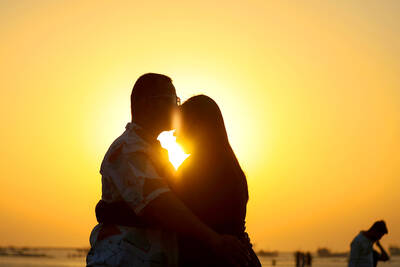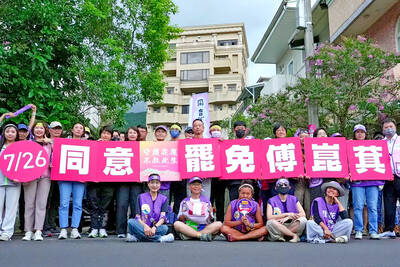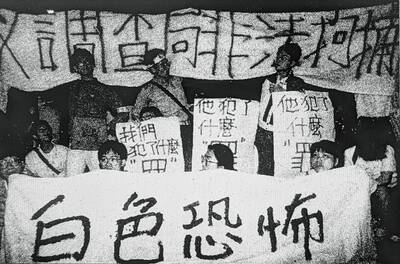A bstract art is notoriously difficult to appreciate because it dispenses with realism in favor of
nonrepresentational expression and often requires a deep understanding of an artist’s psychological or emotional state.
Although Yeh Chu-sheng’s (葉竹盛) oil and acrylic on canvas paintings can be said to fall into this category, the Leisure Art Center (悠閒藝術中心) presents his works in a way makes them easily accessible.
Entitled Infinity, the small exhibition displays 11 medium-sized paintings that Yeh completed in the past year, with two works dating from the 1990s, and provides a brief survey of the artist’s interests over the past decade: Taiwan’s natural environment and the natural cycle of growth and decay.
While abstract art’s visual language is sometimes frustrating because it lacks a clear visual reference to the phenomenal world, the center compares and contrasts Yeh’s works of patches and swaths of seemingly random lines to other abstract artists and supplemented the exhibit with a section devoted to Yeh’s preliminary sketches. These realistic studies of stems, seeds, flowers and other natural phenomena illuminate the non-representational canvases. It is advised that anyone visiting the gallery take a look at them first because they provide a solid starting point from which to approach the main works.
In Marine · Creature (海洋 · 生物), Yeh paints the canvas dark blue and creates texture by the addition, here and there, of blobs of ultramarine, pools of black and veins of peacock blue — as if to suggest different watery depths. Swirling within this aquarium of abstraction are elongated lines painted in cadmium yellow, some tinged with white. The shapes vaguely appear as an anchor, fish and cylindrical ocean creatures.
Marine Ecology (2) (海洋 · 生態 2) features fewer creatures, but continues the theme of ocean blues, with the addition of branches of purples and pinks that connote coral.
Other canvases move the action above the water’s surface. A small bird balances on the edge of a thick blade of dark grass that seems to have exploded from the center of a pod in Flower · Zen (4) (花 · 禪 4). The painting, which is the only representational canvas on display, is reminiscent of Chinese flower-and-bird painting both in its monochromatic use of color and the simplicity of its background.
In Flower · Zen (8) (花 · 禪 8), Yeh takes the viewer in a different direction in terms of the application of paint, use of color and mode of representation. A mass of dappled yellows fills the canvas, creating a dynamic rhythm between the malachite and emerald green background — a combination of color that indicates growth and decay.
Ecosystem (16) (環境 · 生態 16) reminded me of the cliffs at Yehliou (野柳), on the northern coast. A rectangle of red ochre color stretches across the lower quarter of the canvas above which is a large splat of black superimposed over a background of a tempestuous grayish-black wash, which forms the upper two thirds of the canvas.
The other third is given over to another rectangle that itself looks like a canvas, painted in a combination of pale yellow and brown. At the top of this canvas-within-a-canvas, yellow powder pigment is combined with red and blue twine and juxtaposes the black sun in the center of the canvas.
Like many of Yeh’s other paintings, he here uses powdered pigment as a means of replicating the texture of mountains while a thickening agent, applied here and there, ripples the acrylic paint in a manner reminiscent of waves.
Although brief, the Infinity exhibit provides an excellent overview of Yeh’s works and, more generally, to the genre of abstract art. The exhibit stands out for combining the representational with the non-representational, realism with the abstract, and thus enabling viewers to use the former as a means of gaining a deeper understanding of the latter.
EXHIBITION NOTES:
WHAT:Infinity — Yeh Chu-sheng solo exhibition
WHERE:Leisure Art Center (悠閒藝術中心), 6F, 222, Zhongxiao E Rd Sec 4, Taipei City (台北市忠孝東路四段222號6樓)
WHEN: Until May 31 [UPDATE: On May 27 the organizers extended the exhibition until June 7]. Open daily from 10am to 8pm; closed Mondays. Call (02) 2778-0238
ON THE NET:www.leisureart.com.tw

When life gives you trees, make paper. That was one of the first thoughts to cross my mind as I explored what’s now called Chung Hsing Cultural and Creative Park (中興文化創意園區, CHCCP) in Yilan County’s Wujie Township (五結). Northeast Taiwan boasts an abundance of forest resources. Yilan County is home to both Taipingshan National Forest Recreation Area (太平山國家森林遊樂區) — by far the largest reserve of its kind in the country — and Makauy Ecological Park (馬告生態園區, see “Towering trees and a tranquil lake” in the May 13, 2022 edition of this newspaper). So it was inevitable that industrial-scale paper making would

Asked to define sex, most people will say it means penetration and anything else is just “foreplay,” says Kate Moyle, a psychosexual and relationship therapist, and author of The Science of Sex. “This pedestals intercourse as ‘real sex’ and other sexual acts as something done before penetration rather than as deserving credit in their own right,” she says. Lesbian, bisexual and gay people tend to have a broader definition. Sex education historically revolved around reproduction (therefore penetration), which is just one of hundreds of reasons people have sex. If you think of penetration as the sex you “should” be having, you might

Hualien lawmaker Fu Kun-chi (傅?萁) is the prime target of the recall campaigns. They want to bring him and everything he represents crashing down. This is an existential test for Fu and a critical symbolic test for the campaigners. It is also a crucial test for both the Chinese Nationalist Party (KMT) and a personal one for party Chairman Eric Chu (朱立倫). Why is Fu such a lightning rod? LOCAL LORD At the dawn of the 2020s, Fu, running as an independent candidate, beat incumbent Democratic Progressive Party (DPP) lawmaker Hsiao Bi-khim (蕭美琴) and a KMT candidate to return to the legislature representing

July 21 to July 27 If the “Taiwan Independence Association” (TIA) incident had happened four years earlier, it probably wouldn’t have caused much of an uproar. But the arrest of four young suspected independence activists in the early hours of May 9, 1991, sparked outrage, with many denouncing it as a return to the White Terror — a time when anyone could be detained for suspected seditious activity. Not only had martial law been lifted in 1987, just days earlier on May 1, the government had abolished the Temporary Provisions Effective During the Period of National Mobilization for Suppression of the Communist